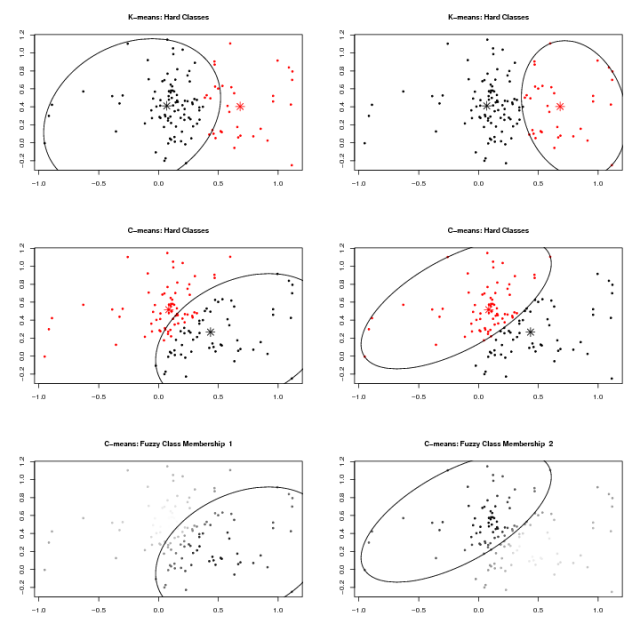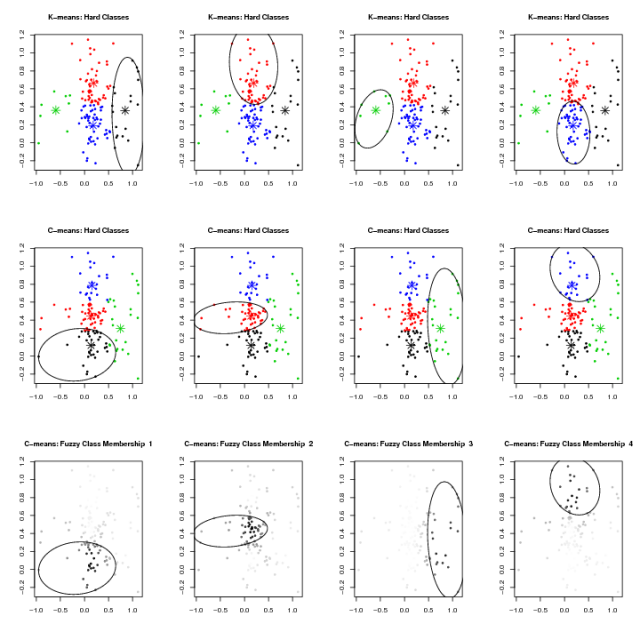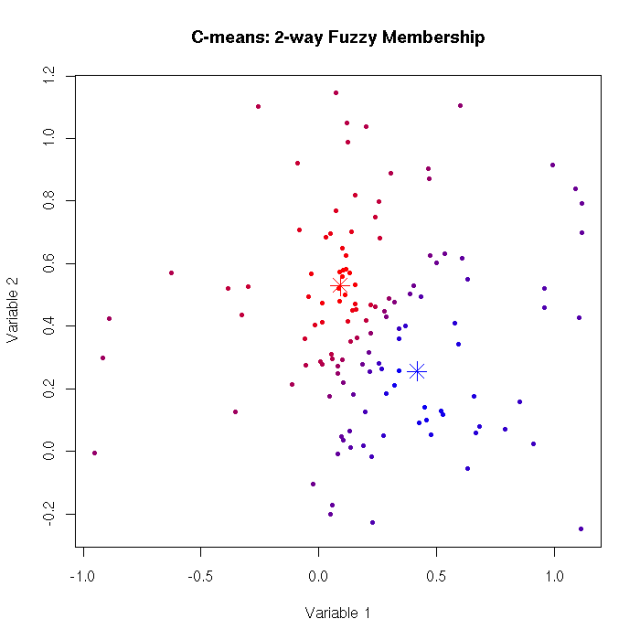Home » Software » R: advanced statistical package » Cluster Analysis 1: finding groups in a randomly generated 2-dimensional dataset
Cluster Analysis 1: finding groups in a randomly generated 2-dimensional dataset
Examples based on a random data set (see example code below), illustrating some of the differences between the K-means and C-means clustering methods as implemented in R. Next time an example with soil profile data collected from the Pinnacles National Monument soil survey efforts. An online version of the PINN soil survey will be available soon here.
Articles:
- Quick tutorial on clustering approaches
- Lecture on K-means algorithm
- Notes on hierarchical clustering
 Figure 1. Two class example |
 Figure 2: Four class example |
 Figure 3: 2-way fuzzy membership |
Example in R:
## load required packages:
require(cluster)
require(e1071)
## make a dateset with 5 populations
x <- matrix( c(
rnorm(50, mean=.3, sd=.5),
rnorm(50, mean=.16, sd=.1),
rnorm(50, mean=.4, sd=.3),
rnorm(50, mean=.6, sd=.2),
rnorm(50, mean=.2, sd=.2)
), ncol=2)
## load function membership() : see attached file at bottom of page
source('cluster_demo_function.R')
## run an example with 2, then 4 classes: See Figures 1 and 2
membership(x,2)
membership(x,4)
## two-way fuzzy membership illustrated with color: See Figure 3
## display 2-way fuzzy membership
plot(x, main="C-means: 2-way Fuzzy Membership", type="n", xlab="Variable 1", ylab="Variable 2")
points(cc$centers, col = c("red", "blue"), pch = 8, cex=2)
points(x, col = rgb(cc$membership[,1], 0 ,cc$membership[,2]) , cex=0.5, pch=16)
Attachment:
Software
- General Purpose Programming with Scripting Languages
- LaTeX Tips and Tricks
- PostGIS: Spatially enabled Relational Database Sytem
- PROJ: forward and reverse geographic projections
- GDAL and OGR: geodata conversion and re-projection tools
- R: advanced statistical package
- Access Data Stored in a Postgresql Database
- Additive Time Series Decomposition in R: Soil Moisture and Temperature Data
- Aggregating SSURGO Data in R
- Cluster Analysis 1: finding groups in a randomly generated 2-dimensional dataset
- Color Functions
- Comparison of Slope and Intercept Terms for Multi-Level Model
- Comparison of Slope and Intercept Terms for Multi-Level Model II: Using Contrasts
- Creating a Custom Panel Function (R - Lattice Graphics)
- Customized Scatterplot Ideas
- Estimating Missing Data with aregImpute() {R}
- Exploration of Multivariate Data
- Interactive 3D plots with the rgl package
- Making Soil Property vs. Depth Plots
- Numerical Integration/Differentiation in R: FTIR Spectra
- Plotting XRD (X-Ray Diffraction) Data
- Using lm() and predict() to apply a standard curve to Analytical Data
- Working with Spatial Data
- Comparison of PSA Results: Pipette vs. Laser Granulometer
- GRASS GIS: raster, vector, and imagery analysis
- Generic Mapping Tools: high quality map production

